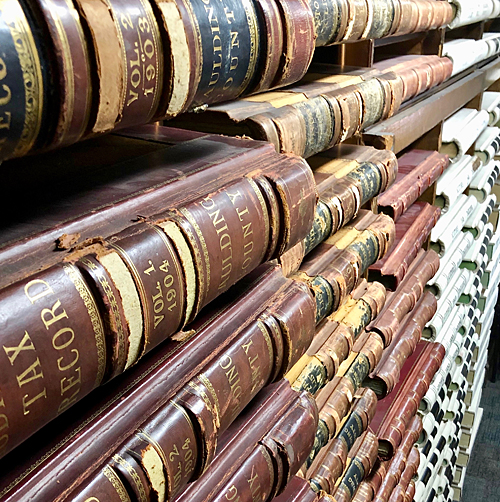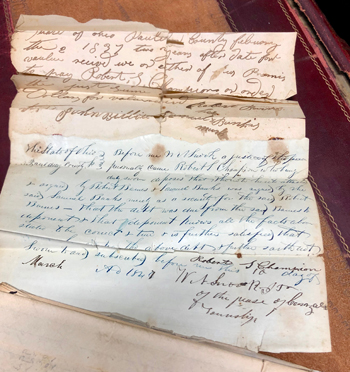Courthouse stores many old documents
Editor’s note: This article is one of a series on Paulding County’s bicentennial (200th year) celebration.
JANE NICE/for the Van Wert independent
PAULDING — Following the Bicentennial kick-off program at Branch Christian Fellowship Church the evening of February 12, dignitaries and celebrants crossed the street and flooded the Paulding County Courthouse hallways to admire the building’s historic interior and witness the unveiling of 22 pictorial montages displayed there.

As county residents stood in the hallways of the courthouse that night munching on cookies, swapping stories about memories the historical pictures jogged, and looking for the faces of their own ancestors, little thought was likely given 130 years after the courthouse was completed to move-in day in July 1888.
Imagine workers trudging up the steps into the freshly plastered building lugging their volumes of books and boxes of records in preparation for conducting official county business in the magnificent new space.
A search has been going on for what records survived fires, floods, and purges to make the move into the courthouse more than a century ago and which remain there to this day. Of course, some records — even the oldest ones — are available online now, and some are stored off-site within the county.
Because Paulding County was first under the jurisdiction of Wood County, then Williams County, some early documents are in those places or archived at Bowling Green State University (more on these records in a later article).
What early records remain right here within the courthouse, and where are they kept? Like a house has closets where its inhabitants store things, the courthouse has vaults — small rooms connected to each office where documents from the past are maintained. These rooms contain custom-made cubbies, dating back to the building of the courthouse, which organize old metal boxes filled with ink-stained papers that reveal the details of Paulding County’s early business.
In addition to these metal boxes, giant leather-bound books — some as big as 18 inches by 14 inches and 3½ inches thick, and weighing more than 30 pounds — rest on their backs on wooden rollers in individual slots spanning all the way from the floor to the ceiling in some vaults. The rollers are necessary to ease the moving of the massive volumes in and out of their spaces.
As the books, heavy with the weight of history, glide from their resting places into the hands of a researcher, the dust drifts and glistens about the room. Opening a volume reveals lines and lines and lines of cursive handwriting, fancy swirls and curlicues distinct to communication from a bygone era. One has to practice and adjust in order to read from the old script. If a sneeze works itself up, one has to turn away from the book or run from the vault so as not to damage the pages.
Besides the actual written records, these books contain hidden treasures: slips of paper attached with rusty clips or straight pins or just floating between pages that reveal letterheads from businesses, attorneys, and county officials long gone. Some of the printed materials are quite fancy and ornate, while some are simply handwritten notes on scraps of paper by citizens who are corresponding with county officers.
These hand-written volumes contain the signatures of some important early officials, such as Judge Emery Potter, Judge Alexander Sankey Latty, General Horatio N. Curtis, Judge Fielding Cable, and more, while many documents are signed with a simple “X” by citizens who did not have the benefit of education to learn how to write their own names.
Within the records, colorful names of regular Paulding County residents like “Deliverance Brown” and “Resolved White” stand out as being unusual.
Which office within the courthouse holds the earliest records? As detailed in an earlier article in this series, the earliest records date back to the beginning of time — for Paulding County at least. They are the original field survey notebooks used by surveyor John W. Powell and his assistants in 1819 to establish the boundary lines of what would become Paulding County the following year. These 200-year-old records are in the Paulding County Engineer’s office in the basement of the courthouse.
The surveyor’s notes from his field books are compiled into a volume titled “Record of Field Notes, U.S. Surveys, Paulding County.”
In 1819, the surveyor and his crew began their work in the southwest quarter of the soon-to-be-established Paulding County, in what would later be named Benton Township. Because the western border of the county was established on the 84 degrees west longitude line and the southern border was roughly on the 41 degrees north latitude line, this southwestern township had two key lines from which the surveyor could work.
The vault with the next earliest records is in the Recorder’s office on the main floor of the courthouse. The pages within these volumes have been digitized and can be accessed on computers, which they often are as people actively search for land and deed records during the sale and transfer of property, but the actual books are all still in the vault, resting on their rollers from floor to ceiling.
The earliest land sales reflected in these deeds took place in 1824. Three separate deeds for Paulding County properties were found, all having been purchased from the land office in Piqua on the same date, August 9, 1824, and all from the United States of America.

John Oliver, from Piqua, bought just shy of five acres in what would later be Auglaize Township. Samuel Reynolds from Delaware County purchased the other two properties: one in Section 11 of what would later be Crane Township and the other in Section 12 of the same. Together, these properties totaled around 100 acres on the banks of the Maumee River.
Were there other purchases of Paulding County property around that time? It is possible. These deed records are indexed by the date they were recorded, which could be soon after the purchase, or much later. In 1824, transportation in the swamp prevented early recordings. The Oliver purchase was recorded in 1832, but for reasons unknown, the Reynolds purchases were not recorded for almost a century, in 1906 and 1910.
To find the next earliest records, one has to climb the staircase to the second story of the courthouse and explore the vault in the County Probate Court. There, stored in a metal box labeled “A1,” are papers relating to the settling of the estate of Samuel Banks, dated 1836 and 1837. Some of the writing is illegible and some of the fragile scraps of paper are joined together with red wax.
The first marriage recorded in the county after Paulding came under its own jurisdiction in 1839 was between George Gamble and Nancy Glassmire, who obtained their license from Justice of the Peace Horatio Curtis on November 16, 1839. The Marriage Certificates Paulding County, 1839-1860, Book 1 can be found in the Probate Court vault.
Documents stored in one of the metal boxes pertaining to an early estate sale list the property of Robert Alexander, late of Brown Township, which was sold at public auction on April 4, 1855. Among the items listed was a handsaw, which sold for 25 cents, and an auger for 50 cents. Elias Alexander purchased both. The auction items that brought the most money were a wagon, which sold for $13, a red cow for $17.50, a gray mare for $34, and a dray mare for $50.50. The entire sale netted $132.48 for Alexander’s estate.
Next time: Early records held in the Paulding County Courthouse, Part 2. More information on the bicentennial can be found on Facebook at www.facebook.com/PauldingCounty200.
POSTED: 02/29/20 at 8:32 am. FILED UNDER: News







